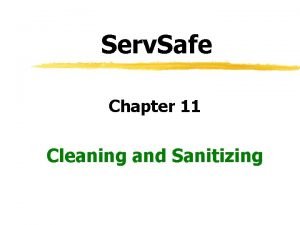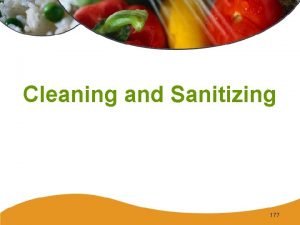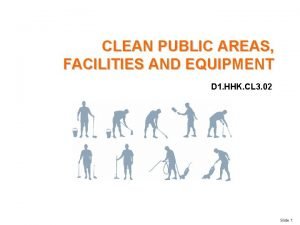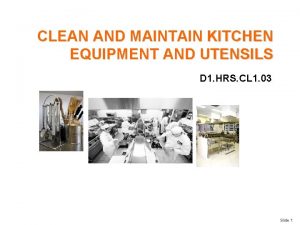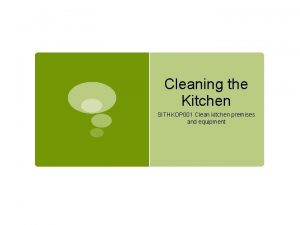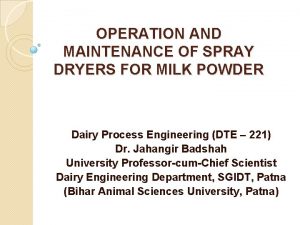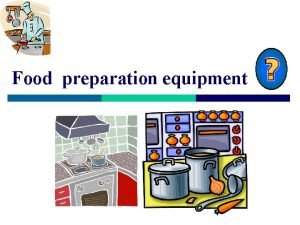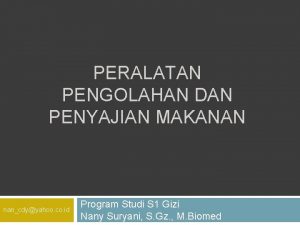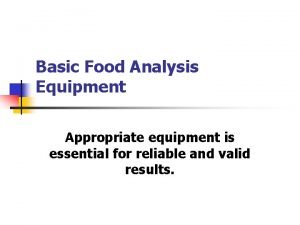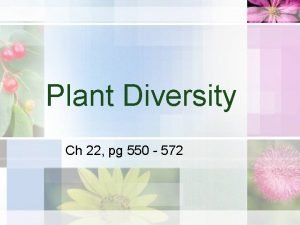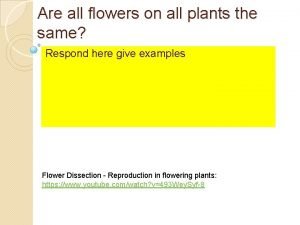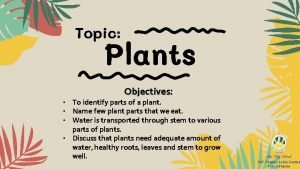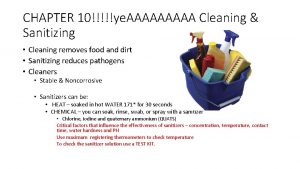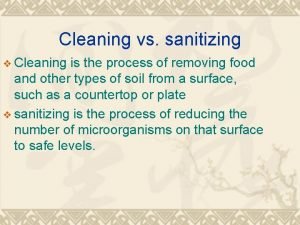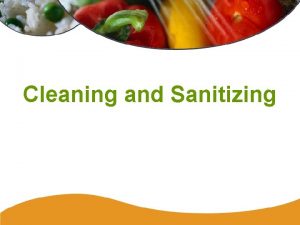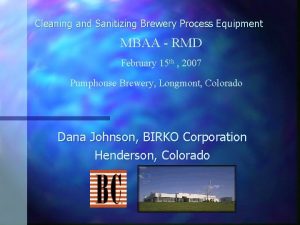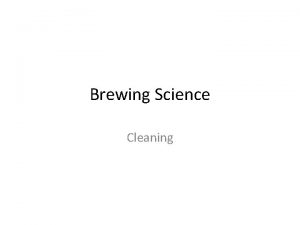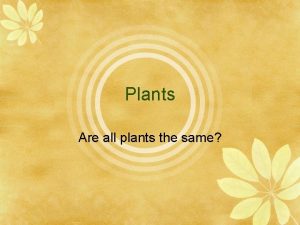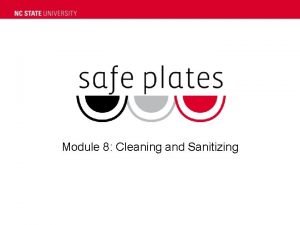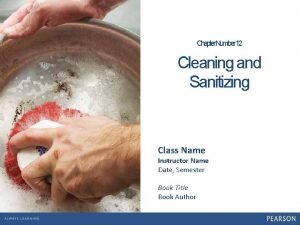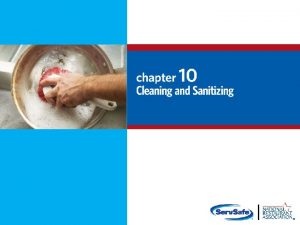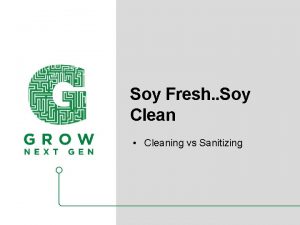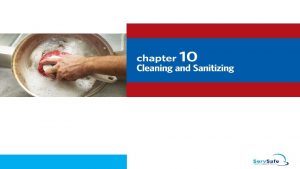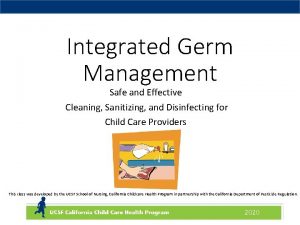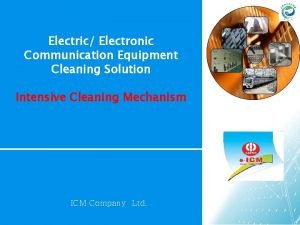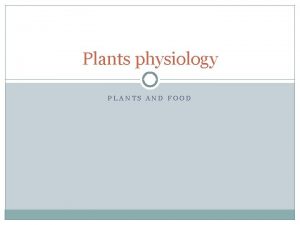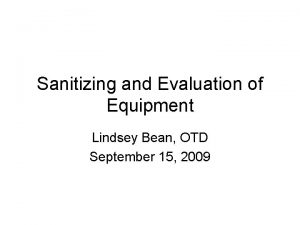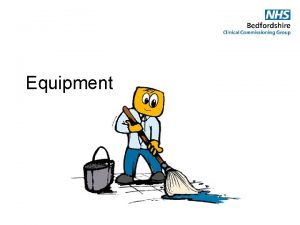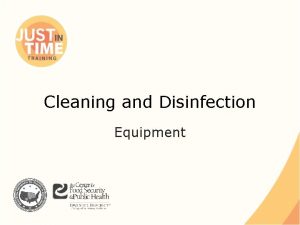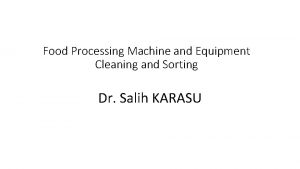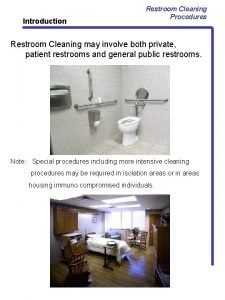Cleaning Sanitizing for Food Plants Introduction All equipment









































- Slides: 41

Cleaning & Sanitizing for Food Plants

Introduction All equipment must be cleaned and sanitized prior to use and following any pause in use that could result in contamination. Specific procedures (SOPs) for cleaning & sanitizing each piece of equipment are available to the operator Effective Cleaning 2

Definition of Cleaning - the complete removal of food soil using appropriate detergent chemicals under recommended conditions. - a process which will remove soil and prevent accumulation of food residue which may decompose or support the growth of disease-causing organism or the production of toxins. Effective Cleaning 3

Definition of Sanitizing - Reducing of microorganisms on surface to safe level - A process which destroys disease causing organism which may be present on equipment and utensils after cleaning 22 Dec 07 Effective Cleaning 4

l Sterilize : statistical destruction and removal of all living organisms. l Disinfect : to inanimate objects and the destruction of all vegetative cells (not spores). l Sanitize refers to the reduction of microorganisms to levels considered safe from a public health viewpoint. 22 Dec 07 Effective Cleaning 5

Food Soil Food soil : unwanted matter on food-contact surfaces. visible or invisible. The primary source: - food product being handled. - minerals from water residue - residues from cleaning compounds - Microbiological bio-films Effective Cleaning 6

Food Soils Classification: l Soluble in water (sugars, some starches, most salt) l Soluble in acid (limestones, most mineral deposits) l Soluble in alkali (protein, fat emulsions) l Soluble in water, alkali or acid 22 Dec 07 Effective Cleaning 7

l Many complex films contain: combinations of food components, surface oil or dust, insoluble cleaner components, and insoluble hard-water salts. l These films vary in their solubility properties depending upon such factors as heat effect, age, dryness, time, etc. 22 Dec 07 Effective Cleaning 8

Surface Deposit Solubility Ease of Removal Heat-Induced Reactions Sugar Water soluble Easy Caramelization Fat Alkali soluble Difficult Polymerization Protein Alkali soluble Very Difficult Denaturation Starch Water soluble, Alkali soluble Easy to Moderately Interactions with other Easy constituents Monovalent Salts Water soluble; Acid soluble Easy to Difficult Generally not significant Acid soluble Difficult Interaction with other constituents Polyvalent Salts Effective Cleaning 9

Biofilm Effective Cleaning 10

Main purposes of cleaning l l l Remove soils that harbor microorganisms and provide nutrients for their growth Prevent the transfer of ingredients from different batches of products Eliminate soils that affect efficiency of heat transfer Prolong equipment life by removing potentially corrosive materials Facilitate preventive maintenance Effective Cleaning 11

Cleanup steps l Pre-rinse l l Wash l l Removes most bacteria by chemicals, heat, agitation Post-rinse l l Removes gross soils (reduces need for chemicals) Removes most bacteria and soil loosened by washing Sanitize l l Ensures that equipment doesn’t contaminate incoming product Doesn’t compensate for poor wash l “You can’t sanitize dirt!” Effective Cleaning 12

Water l Water comprises approximately 95 -99% of cleaning and sanitizing solutions. Functions: l carry the detergent or the sanitizer to the surface; l carry soils or contamination from the surface. 22 Dec 07 Effective Cleaning 13

l Water must be potable and pathogen- free. l Suspended matter must be kept at minimum level l Soluble iron and Manganese salt less than 0. 3 ppm l Never used HARD WATER 22 Dec 07 Effective Cleaning 14

Cleaning Detergent Alkaline-based Detergents - Sodium Hydroxide Sodium - Hydroxide/Hypochlorite Solutions l Acid-based Detergents - Phosphoric Acid - Nitric Acid l Additives - Surfactants - Chelating Agents - Emulsifiers l 22 Dec 07 Effective Cleaning 15

Cleaner selection Factors to be considered when selecting cleaning chemicals l Nature of soil l l Nature of surface to which soil is attached l l Organic / protein / petroleum-based / inorganic (scale or oxide) Stainless steel / aluminum / rubber / plastics Quality of water available l l Use potable water Hardness (Ca / Mg) will affect performance Effective Cleaning 16

Remember l acid cleaners dissolve alkaline soils (minerals) l alkaline cleaners dissolve acid soils and food wastes Effective Cleaning 17

Cleaning methods 1. Manual l 2. Cleaning-Out-of-Place (COP) l 3. Taking equipment apart and using tank for soaking Cleaning-In-Place (CIP) l 4. Taking equipment apart & using brushes Using circulating solution without taking equipment apart Pressure spraying l Using high or low pressure Effective Cleaning 18

Manual cleaning l Uses lower concentrations of chemicals l Cleaners are formulated for safe use l Brushes are used to apply physical energy l Very labor intensive l Complete cleaning may be difficult if physical energy is not consistent 22 Dec 07 Effective Cleaning 19

Cleaning out of Place (COP) Requires little labor l Good penetration during soaking l Needs good arrangement of parts and agitation to work effectively l Cleaner needs to be selected because of long soaking time l 22 Dec 07 Effective Cleaning 20

Cleaning in Place (CIP) l CIP is used to clean tanks, piping and even workspaces between production batches by automatically recirculating detergent and rinse solutions. l The washing process consists of several cycles in which rinsing material is recycled through the vessels, pumps, valves and other process equipment in the flow system. 22 Dec 07 Effective Cleaning 21

22 Dec 07 Effective Cleaning 22

Clean-In-Place (CIP) Benefits l Reduced Water Usage l Reduced Sanitizer Consumption l Reduced Operating Costs l Reduced Wastewater Costs l Increased Efficiency - Reduced Cycle Times l Increase Available Process Time 22 Dec 07 Effective Cleaning 23

Pressure spraying l Effective for cleaning large areas E. g. floors, walls, irregular areas l Foaming cleaners on walls l l Temperature is reduced on contact l Physical energy varies with proximity 22 Dec 07 Effective Cleaning 24

Effective cleaning Procedures include: l Contacting the soil l Allowing sufficient contact time to react l Maintaining temperature l Providing sufficient energy 22 Dec 07 Effective Cleaning 25

Mechanism of cleaning l Detergent is dissolved in water l Solution is applied to surface to separate soil Water soluble soils are dissolved in water l Cleaner allows water close contact to surface l l Cleaner then loosens soil by reducing its attraction to surface 22 Dec 07 Effective Cleaning 26

Mechanism of cleaning (2) l Soil separation is helped by physical action l l Scrubbing / turbulent flow / pressure spray Soil dispersion begins l l l Soluble soils remain in cleaning solution Clumps of insoluble soil are broken down Fats & strong alkalis create a soluble soap Cleaner and dispersed soil are removed l Surface is rinsed with potable water to remove cleaning solution l 22 Dec 07 Effective Cleaning 27

Cleaner performance Four factors for cleaner effectiveness l Time l 15+ min l Temperature l 60 -70 C (140 -160 F) preferred l Concentration l Recommended by manufacturer l Physical 22 Dec 07 of cleaner energy Effective Cleaning 28

Cleaning Variables Time Temperature Velocity Concentration Velocity 22 Dec 07 Effective Cleaning 29

Purpose of sanitizing l Last step in cleanup process l Requires proper cleaning of surface first l Remove oil / biofilm / cleaner residue l Reduces microorganisms on previously cleaned surface free of pathogens Effective Cleaning 30

Ideal sanitizer Has a rapid kill and wide spectrum of kill l Exhibits good environmental resistance l l l l Not adversely affected by poor water quality or residues Effective over wide p. H range Non-toxic to humans Non-corrosive to surfaces under all conditions Freely soluble Good shelf life Effective Cleaning 31

Effective sanitizing l Use at recommended concentration l More can cause corrosion p. H of sanitizer is formulated for best action l Kill increases with temperature l l l Time of exposure varies l l l Stability can decline Must be capable of 99. 999% kill in 30 sec Contact time of 2 min is common Residual soil affects performance of oxidizers Effective Cleaning 32

Sanitizing Agents l Physical Sanitation l Alkaline-Based Sanitizers Chlorine Quaternary Ammonium l Acid-Based Sanitizers - Hydrogn Peroxide - Peroxyacetic Acid (PAA) - Anionic Acids Iodophores 22 Dec 07 Effective Cleaning 33

General types of sanitization l Thermal Sanitization - hot water or steam for a specified temperature and contact time. l Chemical Sanitization - the use of an approved chemical sanitizer at a specified concentration and contact time. 22 Dec 07 Effective Cleaning 34

Properation & cleanup l Promptly rinse equipment after use with cool to warm water l Properly maintain equipment l Seals and gaskets l Keep l work area clean Reduces amount of difficult cleaning l Follow predetermined schedules l Use chemicals for intended use / concentration Effective Cleaning 35

Portable equipment l Store l properly when not in use Keep from splashing / dust l Re-sanitize before next use l Clean and sanitize if brought out of storage Effective Cleaning 36

Equipment cleanup procedures Remove all product and debris from equipment l Have sufficient room between walls / equipment to allow for cleaning l Have sufficient space underneath equipment for cleaning or seal l Disassemble equipment as necessary: l l Remove / replace shields Clean horizontal debris catchers Remove / replace product contact surfaces Effective Cleaning 37

Equipment for cleanup Washing equipment considerations include: l High pressure systems l l Central / portable Mixing valves (steam + cold water) or hot water systems l Raise temperature for cleaning Proportioning pumps / venturi-metering / foamers l Minimize water use to limit sewer loads l Effective Cleaning 38

Manual cleaning l Completely disassemble equipment l Rinse manually l Brush with cleaning solution l Rinse l Sanitize Before reassembly l Just before processing l Effective Cleaning 39

Remember! l Remove all product l Clean up first using scrapers / brooms l Then clean thoroughly, paying close attention to product contact surfaces l Sanitize clean area so that it doesn’t contaminate new product Effective Cleaning 40

l THANK 22 Dec 07 YOU Effective Cleaning 41
 What information should a master cleaning schedule contain?
What information should a master cleaning schedule contain? Final sanitizing rinse temperature
Final sanitizing rinse temperature Cleaning public areas facilities and equipment
Cleaning public areas facilities and equipment Make a cleaning job sheet on kitchen premises
Make a cleaning job sheet on kitchen premises Importance of cleaning kitchen premises and equipment
Importance of cleaning kitchen premises and equipment Operation process of spray dryer
Operation process of spray dryer Name three line segments
Name three line segments Vascular vs nonvascular plants
Vascular vs nonvascular plants Vascular vs nonvascular plants
Vascular vs nonvascular plants Non flowering plants classification
Non flowering plants classification C3 plants vs c4 plants
C3 plants vs c4 plants What are producers food web
What are producers food web Unit 2 food food food
Unit 2 food food food Food chain sequence
Food chain sequence Food preparation equipment examples
Food preparation equipment examples Pengertian alat penyajian modern
Pengertian alat penyajian modern Food analysis equipment
Food analysis equipment Contrast gymnosperms and angiosperms
Contrast gymnosperms and angiosperms Genesis all seed bearing plants
Genesis all seed bearing plants All plants have flowers
All plants have flowers Parts of the plants objectives
Parts of the plants objectives Things that have roots
Things that have roots Are all plants multicellular
Are all plants multicellular Fspos
Fspos Typiska novell drag
Typiska novell drag Tack för att ni lyssnade bild
Tack för att ni lyssnade bild Returpilarna
Returpilarna Varför kallas perioden 1918-1939 för mellankrigstiden
Varför kallas perioden 1918-1939 för mellankrigstiden En lathund för arbete med kontinuitetshantering
En lathund för arbete med kontinuitetshantering Kassaregister ideell förening
Kassaregister ideell förening Vilotidsbok
Vilotidsbok Anatomi organ reproduksi
Anatomi organ reproduksi Densitet vatten
Densitet vatten Datorkunskap för nybörjare
Datorkunskap för nybörjare Tack för att ni lyssnade bild
Tack för att ni lyssnade bild Debattartikel mall
Debattartikel mall Autokratiskt ledarskap
Autokratiskt ledarskap Nyckelkompetenser för livslångt lärande
Nyckelkompetenser för livslångt lärande Påbyggnader för flakfordon
Påbyggnader för flakfordon Arkimedes princip formel
Arkimedes princip formel Svenskt ramverk för digital samverkan
Svenskt ramverk för digital samverkan Jag har nigit för nymånens skära text
Jag har nigit för nymånens skära text
